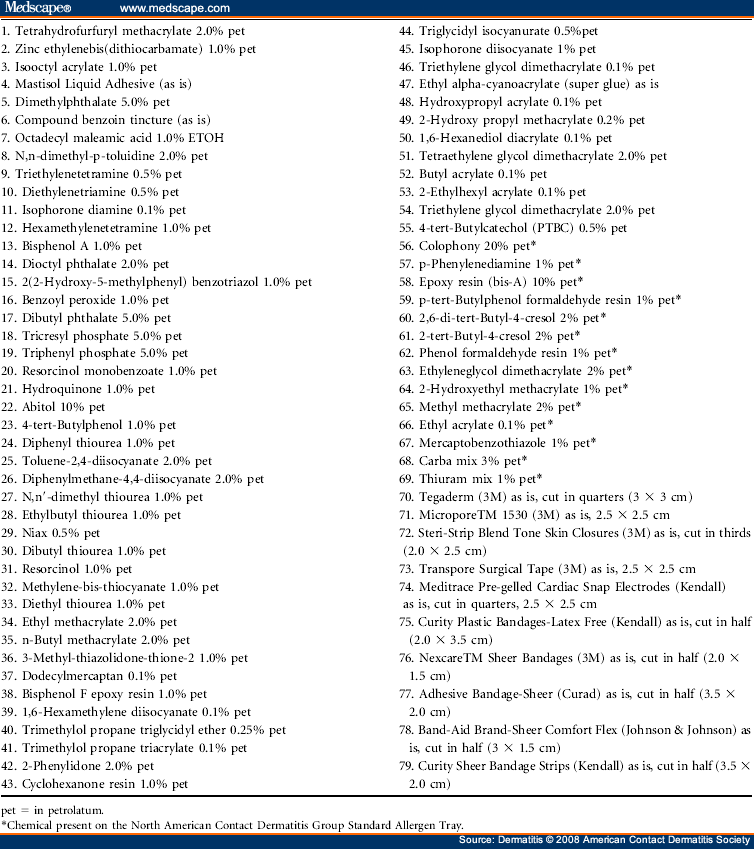Discussion
The described skin reaction to medical adhesive tapes and bandages appears to be primarily an irritant contact dermatitis (ICD). This finding is in line with previously reported data. Marks and colleagues[16] patch-tested 11 patients suspected of having a tape allergy to 33 different items (23 from the NACDG series and 10 additional items, including five tapes or bandages) and found one patient to have ACD from a benzoin-containing solution and another with a likely ACD from thiuram, with no reactions to the tapes or bandages. All of the other skin reactions in their patients were attributed to an ICD. Fisher's Contact Dermatitis clearly states, "Most skin reactions related to adhesive tape are mechanical."[1]
As previously mentioned, our interpretation of an irritant reaction was based on the morphology of thin faintly erythematous eczematous plaques, which were confined to the area of the adhesive and lacked induration. The difference between this and an allergic reaction was exemplified in patients who had both irritant and allergic reactions at the same time (see Fig 3). Additionally, patients that had reactions to the tapes and bandages did not share any common allergic patch-test reactions from the standard or custom adhesive trays, further supporting the fact that the skin reactions to the tapes and bandages were irritant reactions.
The ICD that we observed was much more likely to occur when the tapes or bandages were left on the skin longer (8% [2 of 26 subjects] after 2 days on the skin and 73% [8 of 11] after 7 days on the skin). The fact that irritant reactions were more likely when the materials were re-applied at day 2 is not surprising and is explained in part by Tokumura and colleagues, who reported increased destruction of the skin surface topography and increased transepidermal water loss as adhesive tapes were applied repetitively, secondary in part to stripped corneocytes.[17] It is granted that the one additional application and "stripping" of the bandage or tape in the 7-days group compared to the 2-days group is not likely to be the primary causative factor explaining the ICD. Instead, the strength of the adhesive and the length of time that the adhesive is on the skin is likely the primary causative factor in developing the ICD (Mike D. Bruce, Professional Relations Associate, 3M Pharmaceuticals, personal communication, March 2007).
Of interest to us were the four subjects (15%) with reactions to fragrance mix. The positive allergic reactions were all ++ reactions and vigorous, more prominent than the usual positive reactions to fragrance mix seen in our contact dermatitis clinic. Additionally, the NACDG data report 10.4% of patients as having allergic reactions to fragrance mix.[13] Despite the patch test being negative for allergic reactions to the tapes and bandages in their whole form, this raises the questions of whether there is there something different about these patients and whether possibly a fragrance chemical had been added to the adhesive. Granted, the sample size is very small, but further investigation may be beneficial.
We were particularly disappointed in the lack of cooperation from the adhesive bandage manufacturers. We were never provided with adhesive samples or even a complete list of the ingredients of any of the bandages or tapes that we used in this study, despite numerous phone calls, E-mail correspondence, and in-person meetings with company representatives. The Material Safety Data Sheets obtained for the products that we used in the study were also of very limited benefit owing to their profound lack of detail. For example, the entire ingredient list for 3M Nexcare Active Strips (Nexcare Active Strips, 3M, St. Paul, MN) read, "Foam strip with adhesive and absorbent pad." This lack of cooperation led us to use different resources. For example, the presence of one of the most common acrylates (isooctyl acrylate) used in 3M's adhesive bandages and tapes was discovered by accessing online US patent records[15] and was later confirmed by oral communications with the company. The patent records provided incredible details of both the chemical constituents and manufacturing process involved in all portions of the bandage or tape. Unfortunately, we ultimately were unable to completely overcome the lack of chemical information from the adhesive industry, as not all of the patent records were available for all of the products used in the study. Ideally, to say that a subject does not have an ACD to a medical adhesive bandage or tape, we would want to have a negative patch-test result for both the bandage in its whole form and for each of its chemical constituents. Given that some of our patients did have reactions to some of the bandages in their whole form, which we interpreted as irritant reactions; it would have been even more reassuring to have negative reactions to each of the confirmed chemical constituents. Despite this, we feel very confident that based on the morphology of the patch-test reactions, the reactions were indeed irritant reactions.
CLICK HERE for subscription information about this journal.
Travis J. Widman, MD, Department of Dermatology, Contact Dermatitis Division, 3303 SW Bond Ave., Portland, OR 97239. E-mail: twidman@u.washington.edu
Dermatitis. 2008;19(1):32-37. © 2008 American Contact Dermatitis Society
Cite this: Allergic Contact Dermatitis from Medical Adhesive Bandages in Patients Who Report Having a Reaction to Medical Bandages - Medscape - Feb 01, 2008.







Comments